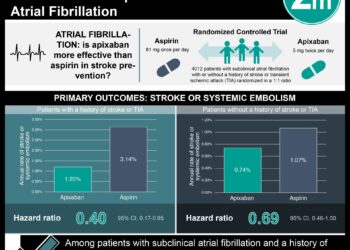2 Minute Medicine Rewind December 31, 2018
Patients that have undergone bioprosthetic aortic valve replacement (bAVR) are at an increased risk of thromboembolism. Recommendations and strategies surrounding the use of antithrombotic medications, however, vary. In this retrospective cohort study, 9060 veterans with bAVR were followed up to describe post-bAVR antithrombotic medication practice across the Veterans Health Administration (VHA) and to assess the association between antithrombotic strategies and post-bAVR outcomes. The 90-day outcomes assess included all-cause mortality, thromboembolism risk, and bleeding events. The most commonly prescribed antithrombotic strategy was aspirin only (46.8%), followed by aspirin and warfarin (18.1%), no antithrombotics (16.0%), dual antiplatelets (11.1%), warfarin only (4.8%) and other only (3.1%). Over the course of the 90-day follow-up period, researchers found that there was no difference in 90-day all-cause mortality or thromboembolism risk when comparing patients who received aspirin only, aspirin and warfarin, or dual-antiplatelets. However, patients receiving both aspirin and warfarin had increased odds of bleeding compared to those receiving aspirin only (adjusted OR 1.92, 95% CI 1.17 to 3.14). The baseline characteristics associated with 90-day bleeding included age, history of coagulation defect, history of bleeding, and history of liver disease. This study therefore shows that the combination antithrombotic strategy of aspirin and warfarin does not improve all-cause mortality or thromboembolism risk, but does increase the risk of bleeding events when compared to the use of aspirin only.
Association of extending hospital length of stay with reduced pediatric hospital readmissions
Rates of hospital readmission are commonly used as a measure of quality of care in hospitalized patients. In adults, a shorter index hospitalization length of stay (LOS) has been found to be associated with a higher risk of hospital readmission, though the same has not been shown in a pediatric population. The aim of this retrospective cohort study (n=956,507) was to explore the association between length of hospital stay and pediatric readmissions. This study used clinical and billing data from 49 children’s hospitals, representing 20% of all US discharges for children. Reasons for condition-specific admissions were determined using the All-Patient Refined Diagnosis Related Groups (APR-DRGs) classification scheme. Researchers found that only 6 APR-DRGs for the index hospitalization had higher readmission rates with shorter hospital LOS. Of these 6 APR-DRGs, asthma, cellulitis and other bacterial skin infections, and nephritis and nephrosis had decreased 15-day readmissions. Dorsal and lumbar spine fusion (for scoliosis), cellulitis and other bacterial skin infections, all normal newborns, and newborns with hyperbilirubinemia had decreased 30-day readmissions. In terms of healthcare resources, depending on the APR-DRG, an estimated additional 18 to 148 hospital bed-days would be required to prevent a single readmission, with accompanying costs ranging from $41,000 to $1.4 million (for dorsal and lumbar spinal fusion). This study therefore shows a lack of robust association between index hospitalization LOS and hospital readmission among children, with few diagnoses demonstrating an inverse association between LOS and readmission.
The provision of effective analgesia in children presenting with injuries in the emergency department presents as a challenge, with pain control efforts often proving inadequate. Intranasal administration of pain medications provides rapid analgesia with minimal discomfort. Ketamine, a dissociative anesthetic, is commonly used in facilitating painful procedures in the emergent pediatric setting. In this study, the Pain Reduction with Intranasal Medications for Extremity Injuries (PRIME) trial, 90 children were randomized to receive intranasal ketamine (1.5 mg/kg) or intranasal fentanyl (2 ug/kg) to determine whether intranasal subdissociative ketamine is noninferior to intranasal fentanyl for the treatment of acute pain associated with traumatic limb injuries in children presenting to the emergency department without routinely administered ibuprofen/acetaminophen. Researchers found that 30 minutes after medication administration, the mean visual analog scale reduction was 30.6 mm (95% CI 25.4 mm to 35.8 mm) for children that received ketamine, and 31.9 mm (95% CI 26.6 mm to 37.2 mm) in the fentanyl group. Pain reduction was sustained over the first 60 minutes for both groups. Ketamine was noninferior to fentanyl in terms of pain reduction 30 minutes after study medication administration. There was no significant difference in highest achieved sedation scores between the groups. Of note, the risk of adverse events was higher in the ketamine group (RR 2.5, 95% CI 1.5 to 4.0), however, all events were minor and transient. The use of rescue analgesia was similar between groups. This study therefore shows that the use of intranasal ketamine may be used in achieving effective analgesia that is noninferior to fentanyl in children with acute extremity injuries.
Ovarian function suppression (OFS) is considered an important aspect of treatment in premenopausal women with advanced endocrine-responsive breast cancer. Degarelix is a gonadotropin-releasing hormone (GnRH) antagonist, which, when bound to GnRH receptors in the pituitary, results in a decreased secretion of gonadotropins. In men, this leads to a rapid decrease in the production of testosterone, and degarelix is approved in the treatment of prostate cancer. In premenopausal women, OFS may be achieved faster with degarelix than with GnRH analogs. The aim of this study was to compare the endocrine activity of triptorelin versus degarelix in premenopausal patients with breast cancer receiving letrozole as neoadjuvant endocrine therapy (NET). In this randomized controlled trial, 51 premenopausal women with stage cT2 to 4b, estrogen receptor and progesterone receptor greater than 50%, and human epidermal growth factor receptor 2-negative invasive breast cancer were randomized to receive triptorelin 3.75 mg (administered intramuscularly on day 1 of every cycle) or degarelix 240 mg (administered subcutaneously on day 1 of cycle 1, and then 80 mg on day 1 of cycles 2-6), both with letrozole 2.5 mg/day for six 28-day cycles. Surgery was performed 2-3 weeks after the last injections. Researchers found that the time to optimal OFS was significantly shorter in patients that received degarelix and letrozole, when compared to the control group (median 3 vs. 14 days, HR 3.05, 95% CI 1.65 to 5.65, p<0.001). OFS was also maintained during subsequent cycles for all patients that received degarelix and letrozole. Conversely, 15.4% of patients in the control group had suboptimal OFS after the first cycle. This study therefore shows that in premenopausal women receiving letrozole for NET, OFS is achieved more quickly and sustained more effectively with the use of degarelix as compared to triptorelin.
Risk of depression and anxiety in adults with cerebral palsy
The motor disturbances seen in patients with cerebral palsy (CP) may also be comorbid with other issues including behavioural disturbance, cognitive difficulties, sensory impairments, epilepsy and intellectual disability (ID). There is little data available on mental health outcomes in adults with CP; however, existing evidence indicates that 20-25% of patients have depressive symptoms. The aim of this retrospective cohort study was to characterize the incidence of depression and anxiety in adults with CP (n=1705) compared with age-, sex- and general practice-matched controls (n=5115) using primary care data from the UK. Researchers found that the individuals with CP were more likely to develop symptoms of depression (HR 1.28, 95% CI 1.09 to 1.51) and anxiety (HR 1.40, 95% CI 1.21 to 1.63) when compared to a matched reference group. When accounting for ID, there were 363 adults with CP who also had ID; only individuals with CP and no comorbid ID had a higher risk of incident depression (HR 1.44, 95% CI 1.20 to 1.72) and anxiety (HR 1.55, 95% CI 1.28 to 1.87). This study therefore shows that adults with CP have an increased risk of depression and/or anxiety, particularly in patients with no comorbid ID.
Image: PD
©2018 2 Minute Medicine, Inc. All rights reserved. No works may be reproduced without expressed written consent from 2 Minute Medicine, Inc. Inquire about licensing here. No article should be construed as medical advice and is not intended as such by the authors or by 2 Minute Medicine, Inc.







